Solid State Drive Market Size
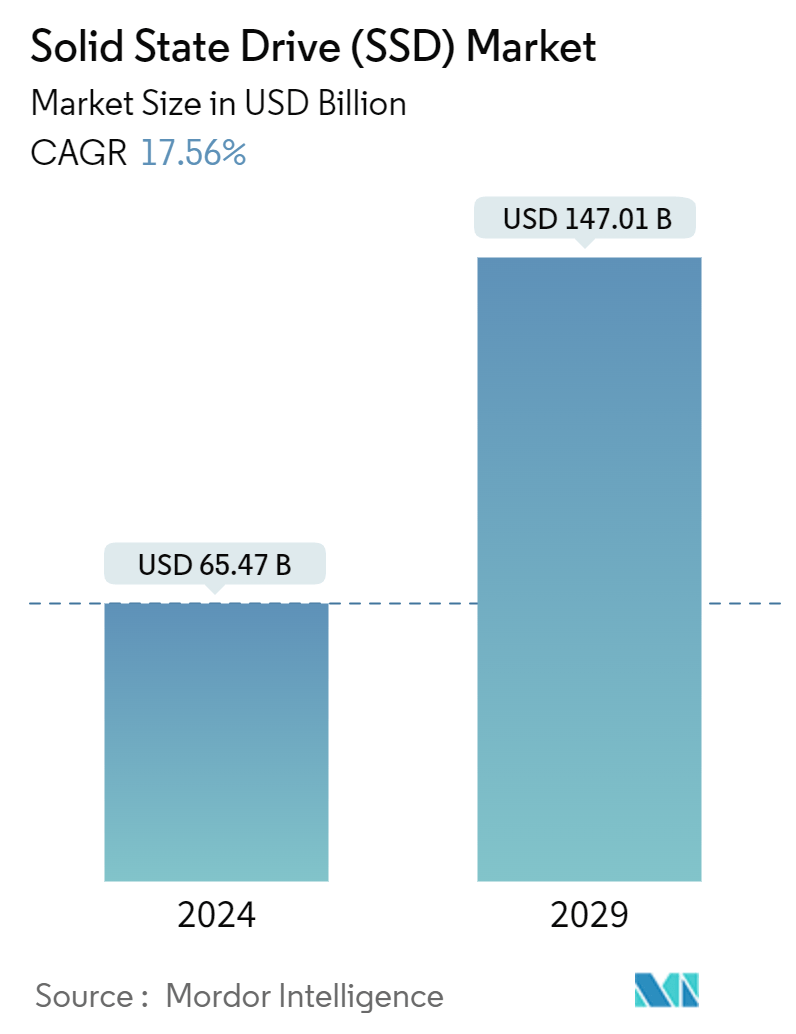
| Study Period | 2019 - 2029 |
| Market Size (2024) | USD 65.47 Billion |
| Market Size (2029) | USD 147.01 Billion |
| CAGR (2024 - 2029) | 17.56 % |
| Fastest Growing Market | Asia Pacific |
| Largest Market | North America |
Major Players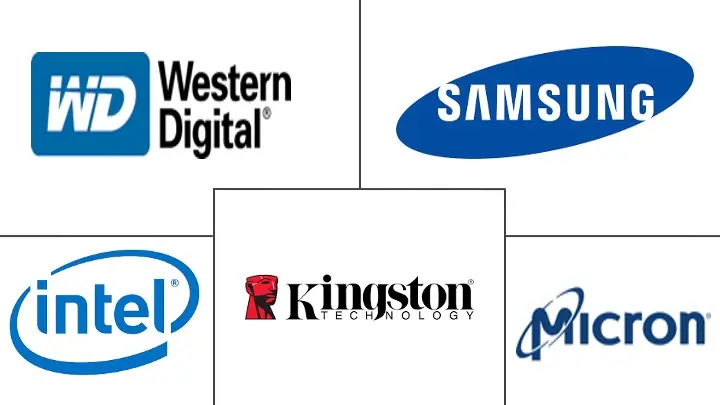
*Disclaimer: Major Players sorted in no particular order |
Solid State Drive Market Analysis
The Solid State Drive Market size is estimated at USD 65.47 billion in 2024, and is expected to reach USD 147.01 billion by 2029, growing at a CAGR of 17.56% during the forecast period (2024-2029).
The data storage demand has been on a massive rise over the past few years, and it is expected to witness an increasing trend over the forecast period. Increasing demand for data storage options is expected to drive the demand for SSD demand over the forecast period.
- The demand for SSD has been rapidly increasing, along with the growing number of cloud platforms, from the traditional corporate private and new public clouds to personal cloud usage. The commonly used SSD interfaces include Serial ATA (SATA), PCI Express (PCIe), and Serial Attached SCSI (SAS). Enhanced features, such as high speed and quick data access, boost the adoption of PCIe SSDs for cloud computing.
- Increasing digitalization and shifting lifestyles are the primary factors of the rise in consumer electronics consumption. The COVID-19 pandemic also compelled consumers to go digital for various reasons, including home-schooling and remote employment and has expedited digitalization in various industries. As a result, the use of SSDs in consumer technology solutions is rapidly rising. This need is projected to continue as technological developments, including IoT, VR/AR, 5G, online technologies, and machine learning, become more prevalent.
- Furthermore, the rise in storage demand has led companies to invest in manufacturing advanced solutions. For instance, in May 2022, Samsung Electronics confirmed a comprehensive collaboration on next-generation storage software innovations. The collaboration will concentrate on creating and testing open-source applications for existing and new memory and storing technologies, such as NVMe SSDs, computational storage (Smart SSDs, HBM-PIM, Smart SSDs), CXL memory, and fabrics.
Solid State Drive Market Trends
Rising Demand from Enterprise Segment to Augment the Market Growth
- Enterprise SSDs lead over a client SSD due to the protection of DRAM-stored data in the event of a power loss, higher performance, stronger error correction code (ECC), consistent and persistent quality of service, and a lengthier warranty.
- The earliest SSDs for enterprises used SLC (single-level cell) NAND flash, which stores one bit per cell and offers the highest level of endurance and performance, with a typical lifecycle of 100,000 writes per cell. Furthermore, NAND-based flash storage solutions are in great demand from organizations due to their long durability, low cost, and quicker storage with a low mistake rate, which drives the need for SSD solutions in enterprises worldwide.
- The growing use of SSD in data centers is due to various factors, including higher efficiency relative to conventional HDD memory, rising demand for storing capacity, and breakthroughs in corporate SSD durability and efficiency. Increasing demand for data centers is expected to propel SSDs demand. SSDs are preferred by businesses since they enable less sprawl, require less energy, and result in a reduced environmental imprint.
- The improvements to NAND flash technology-enabled enterprise SSD manufacturers to use lower-endurance NAND flash options, such as a multi-level cell (MLC), triple-level cell (TLC), and 3D NAND. The advantages of the lower-endurance forms of NAND flash include lower cost and higher capacity, which have increased market growth.
- Increasing product development by market players to meet the rising demand for data centers is expected to contribute to segment growth. According to Cloudscene, by March 2024, the United States led globally with 5,381 reported data centers. Germany followed with 521, and the United Kingdom closely behind with 514.
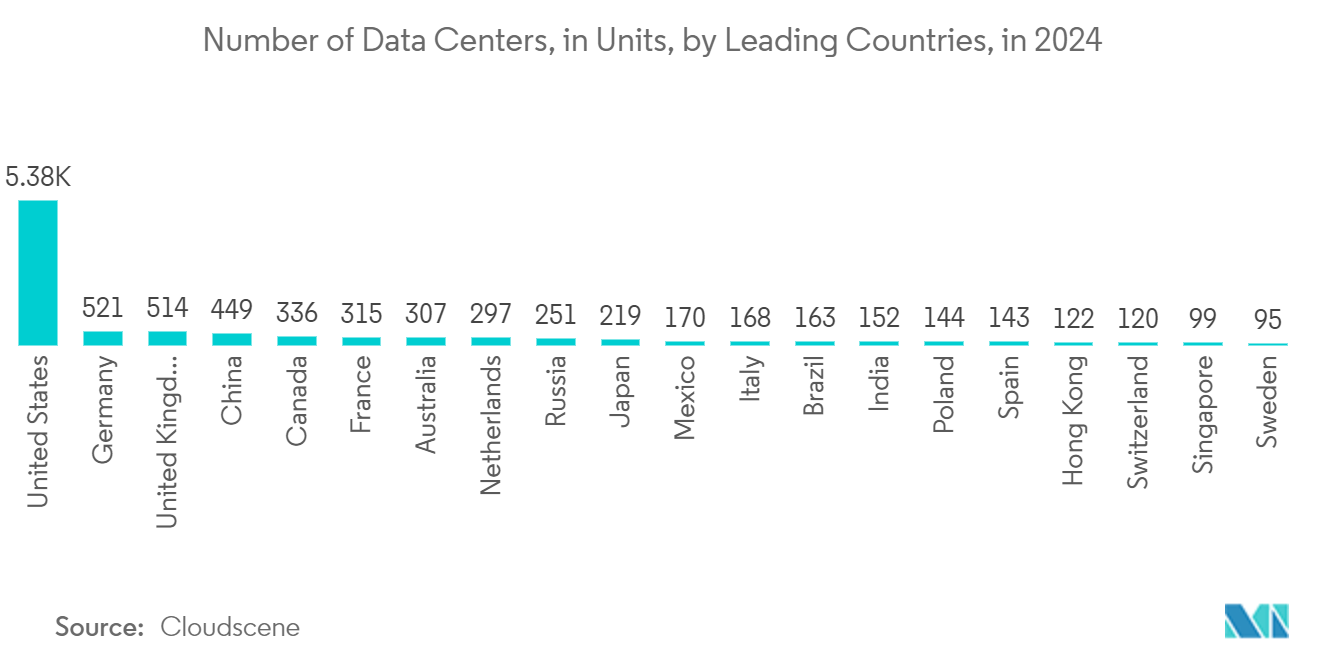
North America Region Expected to Hold Significant Share
- North America is expected to be a prominent market due to the growing adoption of advanced technologies, such as Cloud, IoT, Big Data, and High-end cloud computing. The increasing need for storage, owing to the high adoption of such technologies, drives the market's growth in the region.
- The region includes the world's two largest economically developed countries, the United States and Canada. Prominent North American companies provide various businesses with cutting-edge SSDs as innovative memory options. To gain a competitive edge and enhance corporate efficiency, firms in the United States are increasing expenditures in IT infrastructures which have boosted the demand for storage solutions, including SSD, to increase the speed of data transmission and achieve high levels of efficiency.
- The region has a strong foothold of vendors, contributing to the market's growth. Some of them include Intel Corporation, Micron Technology Inc., and Western Digital Corporation, among others. Additionally, the regional manufacturers are focusing on innovation and product differentiation to increase the penetration of products, increase revenues, and quicken the demand for the product in the region.
- For instance, in June 2022, Micron introduced the 5400 SATA SSD Advanced Memory System for Critical Infrastructure. The company offers 176-layer NAND innovation to its data center SATA SSD using the 5400 SSD. Micron's 5400 SSD is the 11th generation data centre SATA SSD.
- The development of 5G technology in the United States and Canada is expected to contribute significantly to market growth. According to the CTIA, this rapid expansion of 5G will provide the groundwork for a 5G industry in the United States, generating USD 275 billion in investments, 3 million new employment, and USD 500 billion in economic growth.
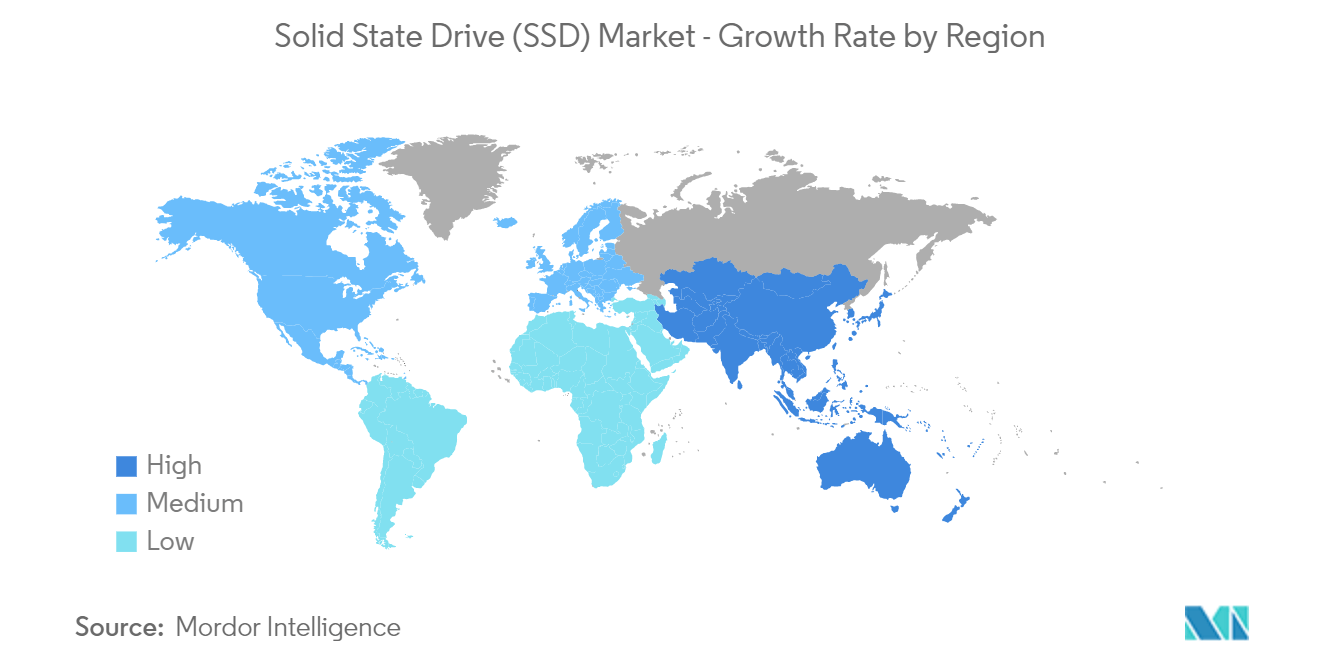
Solid State Drive Industry Overview
The solid-state drive (SSD) market is competitive due to the presence of major vendors, such as Intel, Micron Technology, Samsung Electronics, Kingston Technology Corporation, and Western Digital Corporation. The existing vendors in the market are investing heavily in the R&D of new and innovative products.
October 2022 - CFD Gaming released a PCIe Gen5 NVMe 2.0 M.2 SSD with reading speeds of up to 10 GB/s and write speeds of up to 9.5 GB/s. The SSDs are built on PHISON ELECTRONICS' "PS5026-E26" and utilize Micron's 3D TLC NAND flash innovation.
October 2022 - WD Introduced the Fast SanDisk Pro SSD, which has a twin Thunderbolt/USB port. Western Digital's latest super-fast SSD is one of the company's San Disk Pro line of goods. The PRO-G40 SSD combines Thunderbolt 3 (40Gbps) with USB 3.2 Gen 2 (10Gbps) through a single interface.
October 2022 - Solidigm launched the P44 Pro SSD, a high-performance user SSD for most demanding applications. The P44 Pro has lightning-fast performance and great power efficiency.
August 2022 - Samsung released the 990 Pro Series SSDs. These are NVMe M.2 2280 SSDs with great performance "designed for gaming and artistic applications." The PCIe 4.0 interface is used by the latest Samsung 990 Pro Series SSDs.
Solid State Drive Market Leaders
-
Intel Corporation
-
Samsung Group
-
Western Digital Corporation
-
Kingston Technology Corporation
-
Micron Technology Inc.
*Disclaimer: Major Players sorted in no particular order
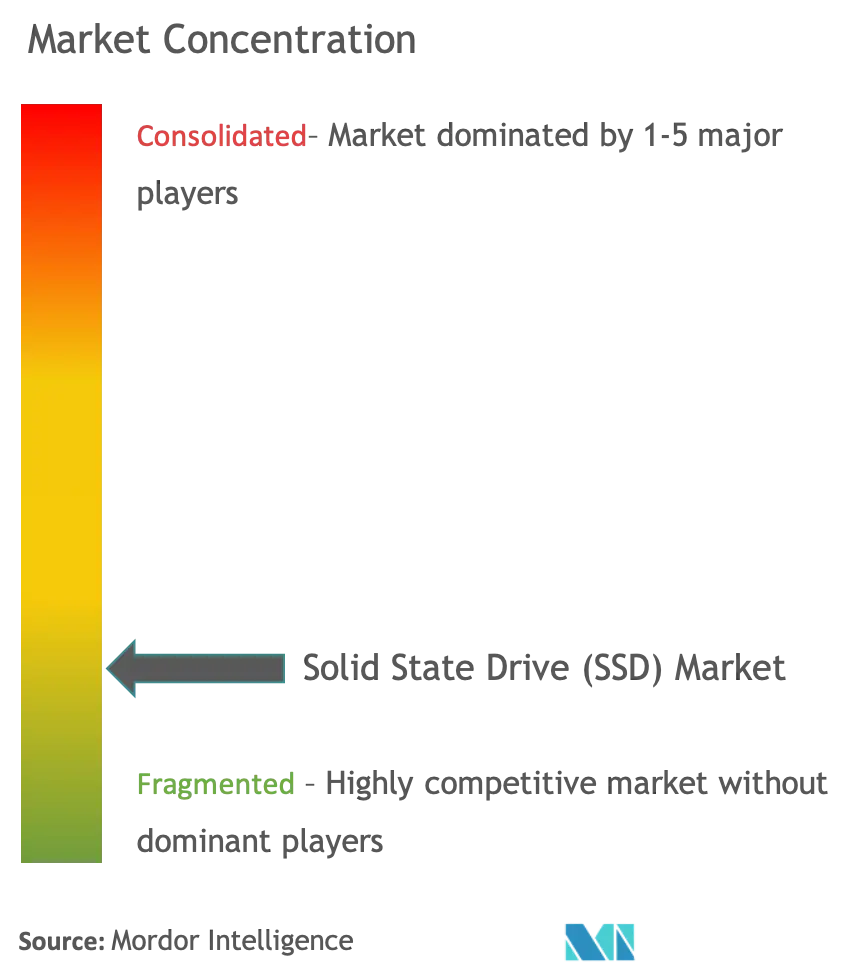
Solid State Drive Market News
- Februray 2024 - Solid State Disks Ltd. SCSIFlash-Fast™, a product from Solid State Disks Ltd., has been introduced as a direct replacement for SCSI interface electromechanical HDDs. SCSIFlash-Fast™ is first introduced with 68- and 80-pin connectors, offering write speeds up to 80MB/s. It utilizes established SCSI drive structure and industrial CFast or M.2 SSD memory, ranging from 2GB to 1TB in storage capacity.
- September 2023 - Western Digital has launched the WD Blue SN580 NVMe solid-state drive (SSD) in India. In a press release, the company said the SSD is aimed at creative professionals, students, and consumers. The SSD is designed to enhance PC performance and enable seamless content creation.
Solid State Drive Market Report - Table of Contents
1. INTRODUCTION
- 1.1 Study Assumptions and Market Definition
- 1.2 Scope of the Study
2. RESEARCH METHODOLOGY
3. EXECUTIVE SUMMARY
4. MARKET INSIGHTS
- 4.1 Market Overview
-
4.2 Industry Attractiveness - Porter's Five Forces Analysis
- 4.2.1 Bargaining Power of Suppliers
- 4.2.2 Bargaining Power of Consumers
- 4.2.3 Threat of New Entrants
- 4.2.4 Threat of Substitute Products
- 4.2.5 Intensity of Competitive Rivalry
- 4.3 Industry Value Chain Analysis
-
4.4 Assessment of the impact of COVID-19 on the Industry
- 4.4.1 Supply chain disruptions to impact the enterprise SSD segment in the short & medium-term as several large-scale organizations continue to stockpile their inventory
- 4.4.2 Marginal rise in prices of Client SSD's which currently offer smaller profit margins as compared to the enteprise segments
- 4.4.3 Stable demand from emerging applications, such as gaming consoles
- 4.4.4 Mapping of the effect of COVID-19 on the overall industry performance for 2021 and 2022
-
4.5 Market Dynamics
- 4.5.1 Market Drivers
- 4.5.1.1 Growing Adoption in Data Center Applications
- 4.5.1.2 High Demand from the High-end Cloud Segment
- 4.5.1.3 Greater Utility of SSD over HDD in Key Verticals
- 4.5.2 Market Challenges
- 4.5.2.1 Concerns over Cost and Total Lifespan of SSD's
- 4.6 Market Opportunities
5. SSD MARKET ANALYSIS
- 5.1 SSD Pricing Analysis
- 5.2 Evolution of SSD Market (in comparison to the HDD)
- 5.3 Unit Shipment Analysis
- 5.4 Analysis of the Storage capacity & Form Factor of SSD and their evolution
6. MARKET SEGMENTATION
-
6.1 By SSD Interface (Overview, Trends, Forecasts & Market Outlook)
- 6.1.1 SATA
- 6.1.2 SAS
- 6.1.3 PCIE
-
6.2 By Application (Overview, Trends, Forecasts & Market Outlook)
- 6.2.1 Enterprise
- 6.2.2 Client
-
6.3 By Geography***
- 6.3.1 North America
- 6.3.1.1 United States
- 6.3.1.2 Canada
- 6.3.2 Europe
- 6.3.2.1 Germany
- 6.3.2.2 United Kingdom
- 6.3.2.3 France
- 6.3.3 Asia
- 6.3.3.1 China
- 6.3.3.2 Taiwan
- 6.3.3.3 South Korea
- 6.3.4 Australia and New Zealand
- 6.3.5 Latin America
- 6.3.6 Middle East and Africa
7. COMPETITIVE LANDSCAPE ANALYSIS
- 7.1 Vendor Market Share Analysis
- 7.2 Analysis of the Key Differentiators and Strategies of Major SSD Manufacturers (Enterprise and Client)
8. COMPETITIVE LANDSCAPE
-
8.1 Company Profiles*
- 8.1.1 Intel Corporation
- 8.1.2 Samsung Group
- 8.1.3 Micron Technology Inc.
- 8.1.4 Western Digital Corporation
- 8.1.5 Kingston Technology Corporation
- 8.1.6 Seagate Technology LLC
- 8.1.7 SK Hynix Inc.
- 8.1.8 ADATA Technology Co. Ltd
- 8.1.9 Transcend Information Inc.
- 8.1.10 Teclast Electronics Co. Limited
9. INVESTMENT ANALYSIS
10. FUTURE OF THE MARKET
** Subject To AvailablitySolid State Drive Industry Segmentation
A solid-state drive (SSD) is a nonvolatile storage media that stores persistent data on solid-state flash memory. SSD is faster, quieter, and generally preferable as compared to hard disk drives (HDD). With a larger capacity, faster speed, and friendlier price, SSD are expected to replace HDDs in the near future comprehensively.
The Solid State Drive (SSD) Market is segmented by SSD Interface (SATA, SAS, PCIE), by application (enterprise, client), and by geography (North America, Asia Pacific, Europe, and Rest of the World). The report offers market forecasts and size in value (USD) for all the above segments.
| By SSD Interface (Overview, Trends, Forecasts & Market Outlook) | SATA | |
| SAS | ||
| PCIE | ||
| By Application (Overview, Trends, Forecasts & Market Outlook) | Enterprise | |
| Client | ||
| By Geography*** | North America | United States |
| Canada | ||
| By Geography*** | Europe | Germany |
| United Kingdom | ||
| France | ||
| By Geography*** | Asia | China |
| Taiwan | ||
| South Korea | ||
| By Geography*** | Australia and New Zealand | |
| Latin America | ||
| Middle East and Africa |
Solid State Drive Market Research FAQs
How big is the Solid State Drive (SSD) Market?
The Solid State Drive (SSD) Market size is expected to reach USD 65.47 billion in 2024 and grow at a CAGR of 17.56% to reach USD 147.01 billion by 2029.
What is the current Solid State Drive (SSD) Market size?
In 2024, the Solid State Drive (SSD) Market size is expected to reach USD 65.47 billion.
Who are the key players in Solid State Drive (SSD) Market?
Intel Corporation, Samsung Group, Western Digital Corporation, Kingston Technology Corporation and Micron Technology Inc. are the major companies operating in the Solid State Drive (SSD) Market.
Which is the fastest growing region in Solid State Drive (SSD) Market?
Asia Pacific is estimated to grow at the highest CAGR over the forecast period (2024-2029).
Which region has the biggest share in Solid State Drive (SSD) Market?
In 2024, the North America accounts for the largest market share in Solid State Drive (SSD) Market.
What years does this Solid State Drive (SSD) Market cover, and what was the market size in 2023?
In 2023, the Solid State Drive (SSD) Market size was estimated at USD 53.97 billion. The report covers the Solid State Drive (SSD) Market historical market size for years: 2019, 2020, 2021, 2022 and 2023. The report also forecasts the Solid State Drive (SSD) Market size for years: 2024, 2025, 2026, 2027, 2028 and 2029.
What are the key factors driving the SSD Market?
Key factors driving the Solid State Drives Market are a) Increasing demand for faster data processing b) Decline in SSD prices c) Growing adoption of SSDs in data centers
Solid State Drive (SSD) Industry Report
The Solid State Drives Market is witnessing substantial growth, propelled by the widespread adoption of SSDs in diverse sectors such as automotive, enterprise, and industrial applications. This market is meticulously segmented based on interface, form factor, technology, storage capacity, and end-user. Key interfaces include SATA, SAS, and PCIe, with SATA dominating due to its cost-effectiveness. Various form factors like 1.8”/2.5”, 3.5”, M.2 are evaluated for their market impact. Technological shifts from SLC to MLC, and MLC to TLC have made SSDs more affordable and increased their storage density, benefiting consumer electronics like notebooks and tablets. The SSD market share is also growing in the automotive industry, driven by the need for high-performance storage in infotainment systems and connected car technologies. North America remains a leader in the SSD market share, due to its advanced technological infrastructure and swift adoption of innovative storage solutions. For detailed insights and a historical overview of the SSD market, including forecasts and revenue growth rates, download a free report PDF from Mordor Intelligence™ Industry Reports. This comprehensive analysis ensures you stay ahead in the Solid State Drives Market, poised for continued expansion due to technological advancements and rising demand across various applications.



